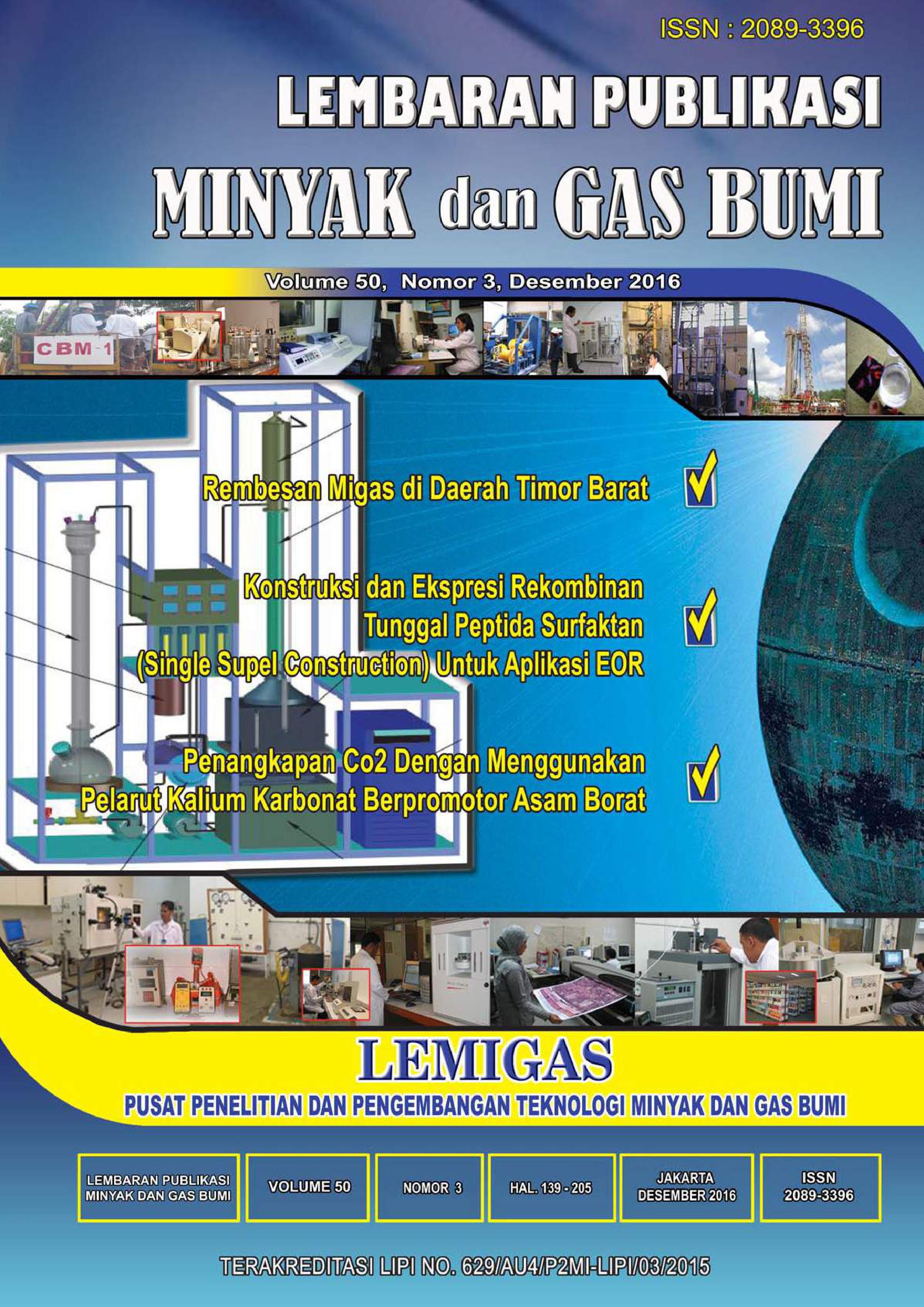KONSTRUKSI DAN EKSPRESI REKOMBINAN TUNGGAL PEPTIDA SURFAKTAN (SINGLE SUPEL CONSTRUCTION) UNTUK APLIKASI EOR (Construction and Expression of Single Recombinant Peptide Surfactant for Eor Application)
DOI:
https://doi.org/10.29017/LPMGB.50.3.3Kata Kunci:
peptida surfaktan, rekombinan tungga, metode reaksi berantai polimeras, perolehan minyak tahap lanjut.Abstrak
Surfaktan yang digunakan pada aplikasi peningkatan perolehan minyak tahap lanjut pada umumnya merupakan hasil sintesis kimia. Hasil sintesis ini bersifat cepat dan efektif namun secara kuantitas sangat kecil, sehingga bila dibutuhkan dalam jumlah banyak akan membutuhkan banyak biaya untuk memproduksinya. Alternatif lain yang bisa digunakan untuk menghasilkan surfaktan adalah dengan rekayasa genetika melalui produksi rekombinan dalam mikroorganisme seperti bakteri untuk menghasilkan surfaktan berbasis peptida. Teknologi ini relatif murah dan simpel untuk dilakukan yaitu dengan manipulasi ekspresi sel inang agar menghasilkan peptida surfaktan yang dikonstruk kedalam vektor ekspresi berbasis bakteri. Pada penelitian ini dilakukan konstruksi peptida surfaktan dengan menggunakan metode overlaped reaksi berantai polimerase untuk menghasilkan surfaktan peptida sebagai peptida tunggal. Hasil analisis SDS PAGE (Sodium Dodecyl Sulphate-Polyacrylamide Gel Electrophoresis) menunjukkan konstruksi peptida surfaktan tunggal dapat diekspresikan dengan cara diinduksi IPTG 1 mM dan dilakukan pemecahan sel untuk mendapatkan protein yang diproduksi diperiplasma. Penelitian ini membuktikan bahwa kedua konstruk berhasil diekspresikan dengan menghasilkan peptida pada ukuran yang sesuai.
Surfactant that is used in enhanced oil recovery applications is generally synthetic chemical result. This synthetic result is quick and effective but very small in quantity, so if the demand in great amount, the more expensive cost needed. The other possible alternative to produce surfactant is by genetic engineering through recombinant production in micro organism such as bacteria to produce peptide based surfactant. This technology is relatively cheap and simple to be implemented, that is by manipulating bacterial based main cell expression. In this research, construction of peptide surfactant using overlapped polymerase chain reaction method to generate surfactant peptide as single peptide. Analysis result of SDS poly acrilamid gel electrophoresis shows that single surfactant peptide construction can be expressed by induction of IPTG 1 mM and also cell cracking to obtain protein which is produced by diperiplasma. This research proves that both two constructions have been successfully expressed by producing peptide in suitable size.
Referensi
Bachmann, R. T., Johnson, A. C., Edyvean, R. G., 2014. Biotechnology in petroleum industry: an overview. International Biodeterioration & Biodegradation , 86, 225-237.
Brown, L. R. & Vadie, A. A, 2002. Slowing production decline and extending the economy life of an oil field: new MEOR technology. Reservoir evaluation & engineering 5(1): 33-41.
Desai, J. D., Banat, I. M., 1997. Microbial production of surfaktants an dtheir commercial potential. Microbiol. Mol. Biol. Rev 61(1): 47-64.
Dwyer, M. D., Brech, M., Yu, L., Middelberg, Anton P. J., 2014. Intensified expression and purification of a recombinant biosurfaktant protein. Chemical engineering science. 105: 12-21.
Kiley P, Zhao X, Bruce BD, Baldo M, Zhang S, 2005. Self-assembling peptida detergents stabilize isolated photosystem I on a dry surface for an extended time. PLoS Biol 3:1181–1186.
Maloy, S., Stewart , V., Taylor, R., 1996. Genetic analysis of pathogenic bacteria. New York: Cold Spring Harbor Laboratory Press.
Maneerat, Suppasil, 2005. Production of biosurfactnts using substrates from renewable-resources. Slongklanakarin J. Sci. Technol. 27 (3): 675-683.
Matsumoto K, Koutsopoulos S, Vaughn M, Bruce BD, Zhang S, 2009. Designer lipid-like peptida surfaktants stabilize functional photosystem I membrane complex in solution. J Phys Chem 115:75–83.
Novagen, 2003. pET System Manual. US: Novagen.
Pacheco, G. J., Ciapina, Elisa M. P., Gomes, Edelvio de B., Pereira Junior, Nei, 2010. Biosurfaktant production by Rhodococcus erythropolis and its application to oil removal. Brazilian Journal of Microbiology 41: 685-693.
Salter, E., Upstoll-Goddard, R.C., Nihtingale, P. D., Archer, S. D., Blomquist, B., Ho, D. T., Huebert, B. Schlosser, P., Yang, M., 2011. Impact of an artificial release on air-sea gas fluxes during deep ocean gas exchange experiment. Journal of geophysical research 116: 1-6.
Sandrea, Ivan & Sandrea, Rafael, 2007. Global oil reserves-recovery factors leave bast target for EOR technologies. Oil and gas journal pp. 1-8
Van Hamme, Jonathan D., Singh, A., Ward, Owen P., 2003. Recent Advances in Petroleum Microbiology. Microbiol. Mol. Biol. Rev 67 (4): 503-549.
Yeh JI, Du S, Tordajada A, Paulo J, Zhang S., 2005. Peptergent: Peptida detergents that improve stability and functionality of a membrane protein glycerol-3-phosphate dehydrogenase. Biochemistry 44:16912–16919. 160











